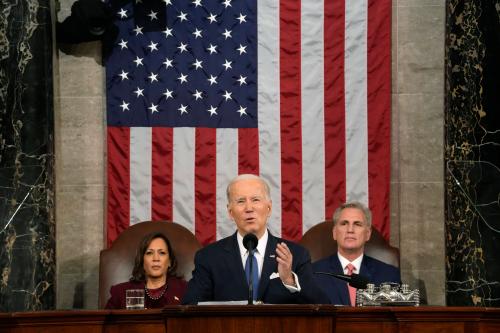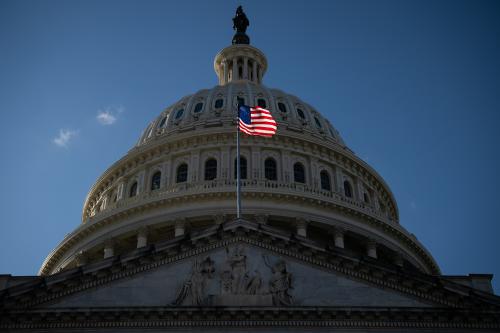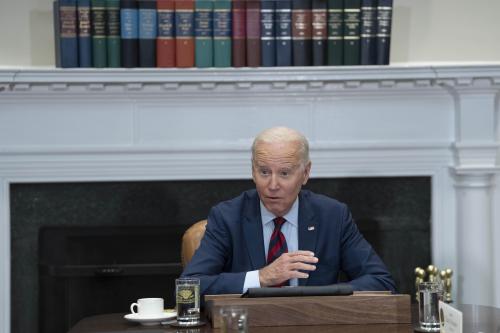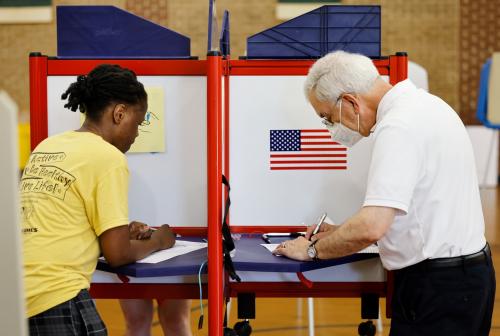The filibuster—the Senate rule that sets a 60-vote threshold to cut off debate allowing a majority of senators to pass a law—has been intensely debated for many years but had become especially controversial in the last Senate where Democrats held exactly 50 seats (with Vice President Kamala Harris able to break the tie by casting the 51st vote). Some progressive Democrats advocated eliminating the filibuster so Democrats could pass legislation to restore the Voting Rights Act, protect abortion rights, and pass robust legislation to reverse climate change by majority rule, but moderate Sen. Joe Manchin (D-WV) disagreed, arguing that the filibuster makes the Senate more deliberative and bipartisan.
Alice Rivlin, who passed away in May 2019, wrote a plea for greater bipartisanship in her final book, “Divided We Fall: Why Consensus Matters” published in 2022 by Brookings Institution Press. In it she rejects the view that the filibuster rule makes the Senate more deliberative and bipartisan and calls for complete elimination of the filibuster. She came somewhat reluctantly to the conclusion that the filibuster rule is being abused when it is invoked routinely for nearly all legislation, as it has been since the Obama administration. This has had the effect of raising the Senate threshold for passage to a 60-vote supermajority, which is not what the Founding Fathers intended.
The book, which we completed for our mother/mother-in-law, discusses the filibuster in depth, starting with the perspectives of James Madison and Alexander Hamilton who believed strongly that a simple majority should decide most issues in the Senate. Madison and Hamilton, two of the authors of the Constitution, had been part of the Second Continental Congress that laboriously drafted the Articles of Confederation the new Constitution would replace. They did not want to repeat the mistake of supermajority requirements that made the lawmaking process under the Articles so laborious. The Senate they were designing would be deliberative but also functional and based on majority rule. Madison argued against a supermajority in Federalist 58, saying if there were such a requirement, “the fundamental principle of free government would be reversed. It would be no longer the majority that would rule: the power would be transferred to the minority.”
Hamilton issued a similar warning in Federalist 22: “If a pertinacious minority can control the opinion of a majority,” the result would be “tedious delays, continual negotiation,” and “contemptible compromises of the public good.” And when accommodation cannot be reached, Hamilton predicted, “the measures of government must be injuriously suspended, or fatally defeated,” and “kept in a state of inaction” and “weakness” bordering on “anarchy.” Sadly, this prediction now seems prophetic.
The Senate, by design, was supposed to be the more deliberative body, but the filibuster was not designed to enhance deliberation, nor to raise the threshold for action in the Senate to a 60-vote supermajority. It was not designed to force bipartisan cooperation to get anything done. In fact, it was not designed at all. It arose totally by accident.
As Sarah Binder, Brookings scholar and colleague of Alice, told the story in a very accessible 2010 Senate Committee testimony, the filibuster was an unintended consequence of an 1806 Senate rules reform advised by Vice President Aaron Burr. In the reform, the senators inadvertently eliminated the rule to “call the previous question”—in other words, to get back to the business at hand. Although the rule had not yet been used this way in either chamber, the House soon learned to use the previous question rule to cut off debate. It would be decades before the senators realized in 1837 that having eliminated their chamber’s previous question motion, any minority of senators, even a single Senator, could block votes just by refusing to end debate, and the filibuster was born.
James Madison had died one year earlier, so none of the authors of the Federalist Papers were alive to object to the Senate that could be ground to a halt by any minority faction. There were objections over the next 80 years, but any proposal to change the filibuster rule died in a filibuster. This changed in 1917 when, on the eve of America’s involvement in the first World War, President Woodrow Wilson pushed adoption of a new rule allowing two-thirds of senators to cut off debate by invoking “cloture,” and for the first time the Senate was governed by super-majorities. There were 96 senators then, so two-thirds set a threshold of 64 needed to move a vote forward. This number climbed to 66 as Alaska and Hawaii became states, and then the threshold was dropped to three-fifths in 1975, which gives us the current 60 vote threshold. But all of this was less important back then because the filibuster was rarely employed.
For the next half century filibusters were reserved for rare times when a minority of senators believed the majority was making a grave mistake, often on the wrong side of history as when Southern Democratic senators like Richard Russell of Georgia and Strom Thurmond of North Carolina (who switched his party affiliation to Republican in 1964) used the filibuster several times in efforts to block passage of civil rights legislation. Through the end of 1970, there was no two-year span of a Congress where as many as ten cloture motions were filed in the Senate.
“As Alice noted, the filibuster has become in practice something it was never intended to be, and it has not been through most of American history: a de facto threshold of a 60-vote supermajority needed to pass legislation through the Senate.”
There were 24 Senate cloture motions filed in the 92nd Congress (1971-1972), an average of one per month. And more routine use of filibusters started in this millennium. When 252 cloture motions were filed in the 113th Congress (2013-2014), it was undeniable that the parliamentary tactic was being abused. As Alice noted, the filibuster has become in practice something it was never intended to be, and it has not been through most of American history: a de facto threshold of a 60-vote supermajority needed to pass legislation through the Senate.
Another Brookings colleague of Alice, Molly Reynolds, wrote a book examining the at least 161 times the Senate has written “Exceptions to the Rule” for filibusters between 1969 and 2014. These include congressional budgets, reconciliation bills, and “fast-track” processes for trade bills and military base closings. More recently, and quite contentiously, Senate Democrats eliminated the filibuster for presidential executive appointments and lower-level court nominations in 2013. Senate Republicans eliminated the filibuster for Supreme Court nominations in 2017.
Even if it was not part of the original design, there was a time it could be argued that, in practice, the filibuster encouraged bipartisan cooperation. Laws could be modified to avoid engendering enough opposition to sustain a filibuster from the other party. But as Alice writes, when the filibuster becomes nearly universally employed to raise the threshold for every bill to a 60-vote supermajority, the net effect is to diminish bipartisan cooperation. Alice saw the filibuster in its modern usage as a weapon of hyper-partisan warfare, not a tool to end it.
“Divided We Fall: Why Consensus Matters” outlines some partial measures senators could take such as suspending the filibuster for specific legislation, limiting the types or number of filibusters that can be mounted, or returning to the practice of “talking filibusters,” requiring senators to hold the floor and talk as they did before the 1970s. These half measures would be an improvement, especially as part of bipartisan negotiations that helped reduce partisan polarization and increase cooperation on legislation. But we should not kid ourselves, both parties have weakened the filibuster when they took control of the Senate in recent years, and both must assume the other party will end it the next time they take power. The Senate should eliminate the filibuster now because it would reduce partisan gridlock and allow the Senate to address America’s immediate and long-term problems.
Elimination of the filibuster would not bring in an unfettered opportunity to pass legislation without compromise, because the principal exception to the filibuster rule—the reconciliation process defined in the budget law—has proven to be a challenging road that also requires many compromises. Both parties have experienced frustrating struggles, and in some cases failures, to reach the 51-vote majority threshold to pass partisan bills under reconciliation. There are many examples including the Democrats’ struggles to pass Obamacare and the Republicans’ failure to repeal it. But Alice believed that eliminating the filibuster would allow the Senate to get more done, pass more partisan and bipartisan bills, and return the Senate to simple majority rule as the Founding Fathers intended.









Commentary
One more moderate voice for filibuster elimination, Alice Rivlin
February 9, 2023